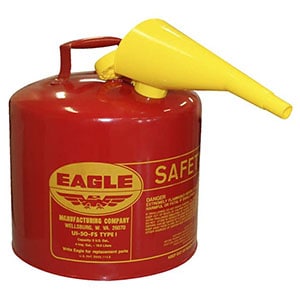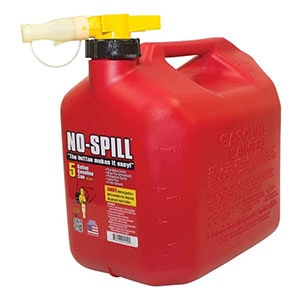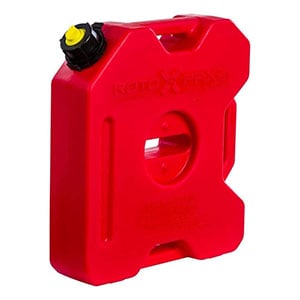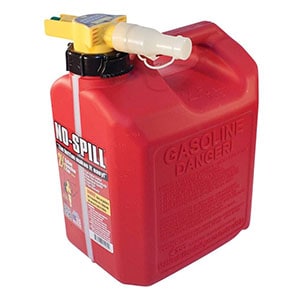A gas can is a metal or plastic container used to safely store or transport gasoline. Many people use them to store fuel around the homestead. Many others keep one in their car or truck in case they ever run out of gas.
Gas cans come in a variety of styles and sizes. Although for practical purposes 5 gallons is typically the upper limit when it comes to capacity.
While gasoline itself does not catch fire easily, the fumes are highly combustible. So it’s crucial to select the right gas can.
Our product experts have put dozens of gas cans under the microscope and found the following to be the 10 best gas cans of 2021.
1. Justrite 5 Gallon Safety Can
The Justrite 5 Gallon Safety Can hits all the right beats when it comes to storing gas either for the short or long-term. It features a Safety-Squeeze trigger that ensures you get a nice, clean pour, an effective flame arrestor to prevent flashbacks and a rugged but comfortable handle that makes for easy transport.
The Justrite 5 Gallon Safety Can is UL-approved and meets all OSHA requirements, so you can bring it to the jobsite to power equipment without hesitation. The can itself is fashioned from high-grade steel with a durable rust proof coating, and it’s easy to fill from the pump. Keep a few of these in the tool shed and you’re ready for any eventuality. Keep one in the car or pickup and you’ll never fear the ‘low fuel’ light again.
2. Eagle UI-50-FS Galvanized Steel Gas Can
The Eagle UI-50-FS is a tough, well-balanced, UL-approved gas storage container with an innovative spout that ensures the gas goes where you want it to go every time. There’s a flame arrestor that prevents fire from sneaking into the can and setting off the vapors, a trigger release that enables precise control over your pour, and the grip is one of the more comfortable you’ll find on any similar-sized gas can.
That innovative spout we mentioned a moment ago warrants revisiting. It effectively prevents spills, no matter what angle you pour from. That eliminates a major hazard, and a major source of waste. The lead-free galvanized can is made to stand the test of time, as is the baked-on powder coat.
3. No-Spill 1450 5-Gallon Poly Gas Can
If you name your company ‘No-Spill’ your product better live up to that promise. Fortunately, No-Spill plastic gas cans typically do. The 1450 5 Gallon Poly Gas Can is our No-Spill favorite for a bunch of reasons. First, the can itself is light and very well balanced. That’s important when you’re lifting, carrying and pouring up to 5 gallons of gas.
Second, for a ‘budget’ can it has a very effective flame arrestor that prevents catastrophic combustion. Third, it’s EPA-compliant so there’s no reason to hesitate keeping one in the tool shed. And finally, the custom spout ensures a nice clean pour every time. If you’re looking for a safe, affordable gas can to store some emergency fuel, consider the 1450 5 Gallon Poly Gas Can from No-Spill.
4. RotopaX RX-1.75G Gasoline Pack
Keeping a gas can secure in the trunk or the back of your truck can be a challenge. The RotopaX RX-1.75G Gasoline Pack solves that problem by providing a convenient and effective mounting bracket (sold separately) that couples with the can and holds it firmly in place no matter the road conditions. It’s the kind of forward-thinking, problem-solving ingenuity we love to see.
But the RotopaX isn’t just for the back of your pickup. It also allows you to keep the can up and out of the reach of small children in the garage or tool shed. And it ensures that you’ll never accidentally tip it over when you’re banging around in the garage. The ‘can’ itself is extremely tough and EPA compliant.
5. Surecan Gas Can 2.2 Gallons
The Surecan Gas Can takes a little getting used to. But once you acclimate yourself to it you might never go back to traditional gas cans. The hook here is the flexible spout that rotates down into any position you require. This eliminates the need to tip the can, and eliminates the danger and waste that accompanies pouring from a traditional gas can.
The Surecan is EPA and CARB (California Air Resources Board) approved and has a child-proof cap to prevent accidents. The can is very well balanced, which makes employing the rotating spout easy and convenient. It’s also tough and covered by a 1 year warranty. All in all a great can to have around to refill your chainsaw, generator, weed whacker or lawn mower.
6. Justrite 7220120 2 Gallon Gas Safety Can
If you loved our #1 pick, the Justrite 5 Gallon Safety Can, but don’t need or want to carry 5 gallons of gas in the trunk of your car, consider its little brother: the 2 Gallon Gas Safety Can. This is a great can to keep in the garage as well to fuel up the chainsaw or get the generator up and running in the case of a power outage.
It shares all the laudable features of the 5 gallon can, including the Safe-Squeeze Trigger, the galvanized steel construction, the flame arrestor, and durable powder coating. And it’s UL-approved and OSHA compliant. You’ll pay more for this than you will for a plastic gas can. But you’re likely to have it for a few decades longer as well.
7. Wavian USA Authentic NATO Jerry Fuel Can
The ‘Jerry’ can was designed during the early stages of World War II for the German army (hence the name, which was slang for ‘German’ at the time). In the 80 years since it first appeared it has become the fuel can of choice for armies all over the world, and for civilians as well. The design has changed very little over the years.
With the biggest change being that many of today’s Jerry cans are fashioned from plastic. Whether or not this product from Wavian is an ‘authentic’ NATO Jerry can is meaningless. The fact is it’s a large, stable, dependable, long-lasting container for storing and transporting gasoline. It won’t win any awards for ease of pouring. But if you need to store a lot of gas around the homestead this is an easy way to do it.
8. No-Spill 1405 2-1/2-Gallon Poly Gas Can
No-Spill gas cans don’t change a lot from model to model. The 2 1/2 Gallon Poly Gas Can is pretty much the same as the 5 Gallon Poly Gas Can, just scaled down. But in this case, that sameness is actually an asset because if it ain’t broke, there’s no need to fix it.
No-Spill cans tell you right up front what they’re all about. And they live up to their name by providing a trouble-free way to store and dispense gas without the mess that often accompanies lesser gas cans. But besides providing a spill-free pour they also have a fire arrestor in the neck, are light but tough, have a 3-gallon per minute flow rate, and are EPA compliant.
9. Garage Boss GB351 5 Gallon Gas Can
The Garage Boss GB351 is a simple, dependable way to store or transport up to 5 gallons of gasoline. The nozzle gives you precise control over the pour with an on/off push button and a generous flow rate. The can is well-balanced, so even if it’s full it’s not unwieldy.
And it has a child-proof cap that prevents the little ones from hurting themselves. We would not recommend this particular gas can strictly for long term storage of emergency fuel. But if you have a few gas-powered tools it’s a good choice as it holds plenty of gas and provides a smooth, drip-free pour.
10. Reda Innovations Fuel Can RGC1001
Because bikers sometimes run low on gas too, we included this Reda Innovations Fuel Can. This is a small (1 gallon) plastic can designed to fit into the saddle bags of your bike. But frankly it’s a great gas can for the car of the RV as well.
This is not a gas can with a lot of bells and whistles. It’s a simple design that pours nice and smooth and is stable when you set it down. The RGC1001 is EPA compliant, does not let your gas evaporate and won’t cost you an arm and a leg.
FAQs
What Should I Look for in a Gas Can?
Materials – There is a fair amount of debate about whether plastic or gas makes for the best gas can. At the end of the day though, it really is six of one and half a dozen of the other. They both have their pros and cons. For instance, plastic gas cans tend to be less expensive. They also tend to be lighter. That can be important if you have to carry the gas any distance. Metal cans, on the other hand, are a bit heavier but they’re also likely to last longer. Just make sure any can is UL approved (1). Cheap, non-UL plastic cans are likely to become brittle with age and may crack and leak without you even knowing it.
Safety Features – The most important safety feature is making sure the can is UL-approved. Beyond that, it’s important that the gas can not allow any external flame to enter. That is prevented by what is called a ‘flame arrestor’ (2). Without a flame arrestor at the spout the danger of a catastrophic fire increases dramatically. Other safety features you should look for include a self-closing lid that will prevent evaporation, and a pressure relief valve that vents pressure and fends off potential explosions. Not all gas cans have all of these. But the more you can get the better.
Capacity – The capacity of your gas can or cans, will depend on your needs. Most gas cans for personal use hold anywhere from one to five gallons. Any bigger than that would be unwieldy. Any smaller, impractical. If you want a gas can for your car then one or two gallons should be enough to get you to the nearest gas station. Around the homestead you may want to keep more just for general use purposes and emergencies. But again, keep in mind that gas cans larger than five gallons are going to be difficult to move.
Ergonomics – Having some gas around in case of emergency is a good idea. But you need to be able to get the gas out of the can and into your chainsaw, generator, or car without spilling it all over the place. That’s where the ergonomics of the can come into play. Vents can make it easier to get a clean pour. A long thin spout can help ensure the gas goes only where you want it to go. And the can should be well-balanced so that it’s easy to lift and pour.
Why Should I Buy a Gas Can?
A gas can means never having to worry about the ‘low fuel’ light – Anyone who has ever spent significant time driving has experienced the dread that comes when the needle is flirting with E and there’s no gas station in sight. Running out of gas, particularly in out of the way places, is a horrible feeling and leaves you vulnerable and exposed. Having a full gas can in the trunk at all times means never having to worry about the letter E.
Gas cans allow you to store gas safely – It’s one thing to have gas stored in the car or around the homestead. It’s another thing to have it stored safely in the car or around the homestead. Keeping gas in old bottles or whatever other containers you can scrounge up is asking for trouble. On the other hand, making sure the gas is always stored in UL approved gas cans means you can sleep well at night.
Gas cans let you prepare for natural disasters – Hurricanes, tornadoes, blizzards, earthquakes and more can happen with little warning. Often times, gas stations are either closed or overwhelmed both before and after natural disasters (3)(4). Storing gas can ensure you’re able to run your gas-powered generator, pump, and other items that will help minimize the impact of the disaster and help put you on the road to recovery.
Gas cans reduce uncertainty and enhance convenience – Knowing that there is always gas on hand for the lawn mower, the chain saw, the portable generator, or to enable you to head for the hills if the SHTF, will reduce worry and stress and add a new layer of convenience to your life.
How Much Gas Should I Keep on Hand?
Most states, cities and towns have regulations in place that govern how much gasoline a homeowner can store on their premises at any one time. In most cases, the line is drawn around 25 gallons. And that is if you own the property where the gas is being stored. If you rent a house, apt or condo, it will likely be stated clearly in the rental agreement that storing gas or other flammables anywhere on the premises is strictly prohibited.
Is it Legal to Store Gas in Your Home?
It is important to check local ordinances before you actually store gasoline on your property. That said, as long as you own the property where you are storing the gas it is usually legal to store gas on that property. That privilege does not usually extend to people renting property, though. As far as where to store it, Ideally, you would look for a place that is both discrete and safe. That means somewhere away from the main house, that can be properly secured, that does not get too hot, and which has adequate ventilation.
Gas should never be stored near a potential ignition source, like a space heater or furnace. It must be stored in safe, preferably UL or EPA-approved, containers. Smoking must be absolutely forbidden in the storage area. The storage area or areas should not be part of the main house. So no storing gas in the basement or attic, or in a garage under the house. It may be okay to store gas in your garage, but only if that garage is separate from the main house.
Is it Smart to Store Gas in Your Home?
Legalities aside there is a more fundamental question that needs answering: is it smart to store gas in your home? Ask 100 people and you will probably get 50 who say ‘yes’ and 50 who say ‘no’. Storing a gallon or two of gas in a secure area is not typically a big deal. But before you go ahead and store 25 gallons of gas in a detached garage or barn you should ask yourself a few questions.
Do local ordinances allow you to store that much gas on your property? Do you really need that much gas? Do you have the right type of containers for the gas you want to store? Who will have access to the storage area? Could someone easily break into the storage area? Does the proposed storage area get baking hot in the summer? Are there any ignition sources in the storage area?
Make sure you have satisfactory answers to all these questions before you go ahead and store more than a small amount of gas on your property.
Does Gas Go Bad?
Gasoline does not come out of the ground ready to be dispensed into your gas tank. The crude oil that comes out of the ground needs to be refined and processed and combined with various additives to turn it into the gasoline that powers your car, truck or SUV (5).
The thing is, over time those various additives and other components begin to separate and the gas evaporates. The gas also loses its combustibility. That is, its ability to ignite and get your engine going. For most grades of gas this breakdown begins after about 30 days. The process is slow, but inexorable. And the longer the gas sits the greater the degradation.
You may still be able to use gas that’s been sitting around for a year or two. But the older the gas, the worse it will be for any engine you try to use it in (6). That engine may wind up sputtering and coughing. Or it may not start at all. If it does start, the old gas may wind up causing serious damage to the engine. This is where gas stabilizers come in.
What are Fuel Stabilizers?
A fuel stabilizer (7) is a liquid you add to the gas which, in effect, prevents it from evaporating. Most of the time fuel stabilizers are used for boats and such that sit for long periods of time between use. But fuel stabilizers can also be very useful if you are storing gas around the house for long periods of time, say, to have in the event of a natural disaster or zombie apocalypse. The biggest consideration with fuel stabilizers is whether it is actually worth the investment.
If you are only keeping a single 2-gallon can of gas in the garage for the chainsaw or lawn mower, spending 10 bucks on fuel stabilizer will not be cost effective. If, however, you’re keeping 25 gallons of gas around the homestead to get you through dark times, you may well want to invest in a fuel stabilizer to make sure that gas is usable should you need to call on it. Be aware though that even fuel stabilizers won’t extend the life of the gas beyond more than a couple of years.
The Bottom Line
Gas cans are one of those decidedly low-tech holdovers from the past that are as relevant and important today as they ever were. They don’t harness the power of the internet. Nor can they be controlled by a nifty app. Instead, their job is to store gas safely until you need it, and then dispense it without making a mess.
If you are not stashing at least a few gallons of gas around the homestead for emergencies, then you are just not as prepared as you should be. Keeping 5 or 10 or more gallons of gas in the garage or shed is a common sense response to an increasingly uncertain world.
Any one of the gas cans on our list will help you live a safer, more convenient life. Use the information in this buyers guide to help you decide which gas can is right for your needs.












